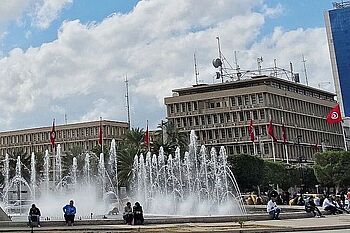The people demonstrating in Tunis on January 21, 2011 hold up signs that read “RCD Dégage” – “RCD disappear.” They are protesting against the state party of the dictator Ben Ali, who ruled the country for decades. These pictures of Tunisian demonstrators were seen all over the world. But Tunisia has yet to create a national memorial for the victims of the dictatorship in Tunisia.
Ministry of the Interior in Tunis

Set behind gushing fountains, the Ministry of the Interior building on Avenue Habib Bourguiba in Tunis looks almost idyllic. But many Tunisians have less-positive memories of this high-security building that served as the residence of the “Directorate of State Security,” Tunisia’s secret police.
The clunky building dates back to the French colonial era. There was a small prison on the ground floor. Interrogations and torture took place on the upper levels. For many prisoners, this was where their years-long odyssey through Tunisia’s prisons began. In March 2011 the Ministry of the Interior announced the dissolution of its State Security Service. In October it invited children to paint the doors of the prison cells with colorful murals. But the site is still not available for public commemoration.
Link
Website of the Tunisian Ministry of the Interior (French)
After the Dictatorship. Instruments of Transitional Justice in Former Authoritarian Systems – An International Comparison
A project at the Department of Modern History at the University of Würzburg
Twitter: @afterdictatorship
Instagram: After the dictatorship
With financial support from the German Federal Ministry for Economic Cooperation and Development
9 April Prison
Nothing suggests that for many decades the largest prison in Tunisia had stood on this overgrown field on Avenue “9 Avril” in Tunis. The prison cell building, designed to hold 1,500 prisoners, was built during the colonial period. But the number of inmates held here during the dictatorship under Bourguiba and Ben Ali was often higher.
After Tunisia acquired independence, thousands of political prisoners were held in the building. It also contained a guillotine, which was still in use in the early 1990s. The prison closed in 2004 and was torn down three years later. After the dictatorship fell, a mass grave was discovered beneath the field.
In 2012, Hamadi Jebali, the prime minister of the moderate Islamist Ennahda party, announced the decision to build a national memorial on the site. But the plans were never realized. In 2017, Tunisian Justice Minister Ghazi Jeribi declared that a courthouse would be built there instead. On June 26, the International Day in Support of Victims of Torture, human rights organizations gathered here to commemorate the detainees who had suffered in the prison.
